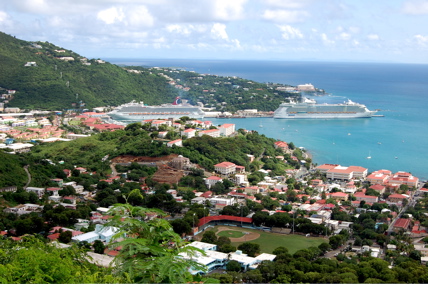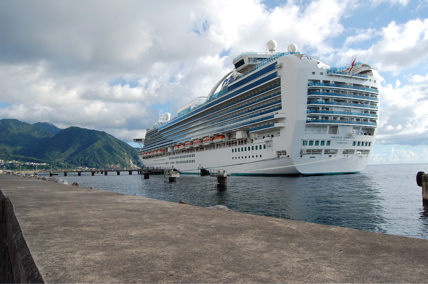This is part 1 of a series I’ve been inspired to write on the environmental impact of cruise travel. I feel this issue is too important (and complex) to cover in just one short post. So bear with me..
Oh, and while it’s no secret that I’m a fan of cruising, I’ll do my best to stick to the facts and be as thorough as possible – if for no other reason than to avoid being branded as a peddler of “travel porn”.
This weekend, a handful of travel writers are departing on the Twitter Press Cruise aboard Crown Princess, a first-of-its-kind publicity stunt that I’m sure the cruise line hopes will generate a lot of good PR for them.
I can already see one major flaw in their plan – they somehow failed to invite us! (I guess we need to get some more Twitter followers).
I’m only kidding, of course – but a few other travel writers have apparently taken serious offense, even going so far as to hijack the #followmeatsea tag to denounce the cruise industry as “travel’s dirty little secret”, and to cast aspersions on the ethics of the participating bloggers.
One outspoken critic even felt compelled to post the following lengthy diatribe (or one like it) on a few of the participants’ blogs – and just about everywhere else she can:
It will be really interesting to see how all the travel writers handle the “twethics” as we all know that large cruise ships do HUGE damage to the environment. It’s the travel industry’s dirty secret, isn’t it?
Sadly, cruise ship companies give so many freebies to travel writers, that most of the public does not know that big cruise ships are the worst possible option in travel for our environment! While many travel companies flounder, cruise ships are a booming business.
Cruising is actually 7x worse than air travel on C02 emissions & most also plane to start the cruise as you will. Not to mention how much waste and garbage these floating cities dump into our oceans! Please look deeper than the sugar coated supposedly “green” policies of a cruise company.
Why is it only travel writers NOT taking all the freebies or advertising dollars from cruise ship companies, doing the important job of educating the public so that our kids & grandkids can enjoy travel too?
Anyone who has sat like we have in tiny, ancient towns like Dubrovnik, Santorini, Capri, Mykonos, or Ephesus & seen the absolute obscene horror of 30 thousand cruise ships’ passengers flood them like a hoard [sic] of locusts, could ever call big cruise ships responsible travel! The damage they do in the Caribbean is also just as bad and well documented.
At the very least, I hope all the twitter writers on this freebie press trip point to the Clean Cruise Ship Act is in Congress now. Travel writers on #followmeatsea press trip can promote petition!
Please don’t just do travel porn that glamorize cruises without giving the complete story! Those of us that are passionate about responsible travel will be following this closely.
It may come as a huge shock to you, but approximately none of the bloggers were motivated to cancel their press trip as a result of this scolding.
However, I was motivated to rise to the challenge and try to uncover “the complete story”. Feel free to follow along, closely or otherwise…
Such comments would be easy to dismiss if they were only the opinion of one or two self-rigtheous travel snobs, but a quick google search reveals dozens of similar articles on the evils of cruising.
Most of them are long on inflammatory language & broad pronouncements, but short on actual figures and statistics to back it up – just like the comment above, which sweeps away the need for such things by stating that the damage is “well-known” and “well documented” (though paradoxically, she also claims that most of the public doesn’t know about it).
One of the industry critics willing to put numbers to the problem is Friends of the Earth, which proclaims on its site that:
In one week alone, a large cruise ship generates approximately:
• 210,000 gallons of human sewage,
• 1 million gallons of gray water (water from sinks, baths, showers, laundry, and galleys),
• 25,000 gallons of oily bilge water,
• Up to 11,550 gallons of sewage sludge, and
• More than 130 gallons of hazardous wastes.
I found these same numbers repeated over and over again on other websites, notably responsibletravel.com and guardian.co.uk, and even in a report from the distinguished Pew Oceans Commission (May 2003).
But where do these shocking figures come from?
After some digging, I found what appears to be the origin: a white paper issued by the U.S. Environmental Protection Agency published in August of 2000.
While it’s encouraging to find that these figures do in fact come from a credible source, I can’t help but wonder if these decade-old statistics still hold true, given that about half of the big cruise ships currently sailing were built after the report was published.
Who knows, maybe now it’s even worse – after all, cruise ships have only been getting bigger. But if that’s the case, why isn’t anyone using the newer figures? Maybe they don’t exist – or maybe they’re being covered up by some huge conspiracy.
Tracking the Carbon Footprints
I’ll take a closer look at those numbers in the next post, but for now, let’s double back to some of the specific claims made in the blog comment I started this article with:
Cruising is actually 7x worse than air travel on CO2 emissions
I found a more detailed exposition of this claim in a December 2006 article in The Guardian:
George Marshall of the Climate Outreach Information Network has conducted a rough initial calculation for the Queen Elizabeth II. Cunard says the ship burns 433 tonnes of fuel a day, and takes six days to travel from Southampton to New York. If the ship is full, every passenger with a return ticket consumes 2.9 tonnes. A tonne of shipping fuel contains 0.85 tonnes of carbon, which produces 3.1 tonnes of carbon dioxide when it is burnt. Every passenger is responsible for 9.1 tonnes of emissions. Travelling to New York and back on the QEII, in other words, uses almost 7.6 times as much carbon as making the same journey by plane.
I couldn’t determine exactly when these calculations were performed, but it’s worth noting that the QE II was built in 1969 & took her final voyage last year. Looking at a database of the approximately 100 big ships currently in use by the major cruise lines, I find that 70 were launched in 1998 or later, for whatever that’s worth.
The same article also contained this quote from carbon offsetting firm Climate Care, about the much newer Queen Mary 2 (launched in 2004):
According to our calculations, a cruiseliner such as Queen Mary 2 emits 0.43kg of CO2 per passenger mile, compared with 0.257kg for a long-haul flight (even allowing for the further damage of emissions being produced in the upper atmosphere)
So it would appear that some ships generate only 1.7 times as big a “carbon footprint” per passenger mile compared to airliners. That’s still significant, of course, but a far cry from the 7x figure that is so authoritatively thrown around by the anti-cruising camp.
Apples to Apples?
Is it fair to compare the carbon footprint of cruise ships to airplanes and leave it at that – or even to compare them at all? Cruise ships aren’t just a means of transportation, after all – they also serve as hotels and entertainment complexes, right?
Surely the people who spend their week-long vacations in places other than cruise ships are also taking showers, using toilets, consuming electricity and otherwise abusing the environment, too, aren’t they? What’s the carbon footprint of that?
Estimates on the website carbonfund.org, tell us that an average traveler generates 31-35 kg of CO2 per day in meals and lodging when staying at a typical hotel (around 217 – 245 kg / week).
Based on all these estimates, then, if my calculations are correct:
a person who takes a transatlantic flight from New York to London & back, spending a week there would be responsible for about 1,800 kg of CO2 from the flights, and up to 245 kg from their dining & lodging, or about 2,045 kg of CO2.
If the same person were to spend that week sailing from New York to Southampton on the Queen Mary 2, they’d account for about 1,500 kg of CO2 while on board, plus 900 for the flight back, for a total of 2,400 kg of CO2 – only 17% more than the air traveler.
Of course, if the air traveler rents a car or takes any taxi rides, we’ll have to add carbon fund’s estimate of 8.87 kg of CO2 per gallon of fuel into account, too, which would make the comparison even less shocking (so let’s not do that).
A Flood of Locusts?
Back to the blogger’s comments:
Anyone who has sat like we have in tiny, ancient towns like Dubrovnik, Santorini, Capri, Mykonos, or Ephesus & seen the absolute obscene horror of 30 thousand cruise ships’ passengers flood them like a hoard [sic] of locusts, could ever call big cruise ships responsible travel!
Well, it would take at least 9 of the largest cruise ships sailing the Mediterranean to unload 30K passengers, and according to the data I can find, the busiest of the ports she mentioned (Mykonos) was never visited by more than 4 big ships on any single day in 2009. Maybe she was just rounding up for the sake of simplicity, I don’t know.

2 mega-ships looming over St Thomas
And I’ll admit that I personally haven’t yet sat in any of those particular towns, but I have witnessed “hordes” of cruise ship passengers pouring into many Caribbean ports of call, both from the sidelines and from within them – and I do understand where she’s coming from on this particular point.
I’m not sure I would go as far as to call it an “absolute obscene horror” (nor would the the thousands of locals who depend on that tourist traffic for their livelihoods), but It would be hard to argue that such an influx – especially when repeated day after day – doesn’t have any impact on the environment and infrastructure of these places.
However, If you’d like to view this from a different perspective, go on Google Earth and look around the Caribbean & Mediterranean ports of call and see if you can spot the big cruise ships. It’s a little harder than you might think.
I realize it may seem like I’m spending a lot of time just picking on one angry activist’s comments, but this is mainly because she’s been very busy spreading these claims all over the internet, and they echo most of the arguments against cruising throughout the blogosphere.
Largely Unregulated?
To address another common complaint about cruise lines, I’ll quote from a different source – an article in aboutmyplanet.com, filed under “conspiracies”:
Although cruise ships are floating cities, they are not required to have discharge permits like cities. They are responsible for 25% of what is dumped into the ocean, and most likely the numbers are much higher then we will ever know.
The only federal laws in the states for ship sewage discharges is that it they have to use approved marine sanitation devices within 3 miles of shore. Canada has no standards for gray water or sewage waste, allowing them to become a dumping ground for American cruise ships traveling to Alaska.
Wow, 25% of what’s dumped in the ocean – really? Since the author cited no source for this startling claim, I’m gonna have to do some research, but it sounds like a bit of a stretch to me. I’m also not sure it automatically follows that cruise ships are in fact doing everything that hasn’t been outlawed.
The major cruise lines will be quick to inform you that they’ve already created their own policies and standards which greatly exceed existing laws, and that they’ve changed their ways since the scandals of the mid-1990’s, but they shouldn’t be surprised if a lot of people don’t believe them.
I’ll do my best to rip apart the industry’s side of the story in a later chapter of this saga. But first, I’ll be taking a more detailed look at the components of cruise ship pollution one by one, and try to explain what things like black water, gray water, and oily bilge water are all about. Sounds like fun, doesn’t it?
I need your help!
Though I’ve literally spent days researching this issue, there are bound to be some important reports or articles that have so far escaped my attention. In order to make sure this report is “fair and balanced” (not in the Fox News way, but the real way), I could use some help.
If you know of any sources of real information (not just rhetoric) that I may have missed, please let me know in the comments, or email marc [at] 4suitcases [dot] com.
And since I think it’s so clever how some of the travel industry’s critics underscore their arguments by quoting old asian proverbs, I’ll close with one I recently came across:
There are only two mistakes one can make along the road to truth; not going all the way, and not starting.
– The Buddha
I think we’ve all gotten past the second of those – now let’s see how far we can get on the first one.






{ 7 comments }
I appreciate your balanced post backed up by thorough research. Although this is a cruise industry source, you might find this information helpful.
http://www.cruising.org/industry/environment.cfm
Thanks, Donna!
I deliberately avoided using at any cruise industry sources for this part of the report (or even looking at them before publishing), since it would be too easy to dismiss them as “propaganda”.
I’m looking at their side of the story in the next chapter, and will be asking some tough questions of them, too.
The blogosphere needs more responsible reporting and less drama queens. This is a good example of what responsible reporting is. Thank you for a good read.
I think the message got lost in all the bickering. Your post is one of the best I’ve seen on a legitimate topic – I don’t know of any research resources to point you to but if I come across any will be sure to email them over.
<>
I admit I am not an environmental expert so I really appreciate this article – if there is MORE to it I would love to see it at editor at cruisemates dot com.
I want to point this out about the QM2 stats above. First of QM2 making a transatlantic voyage is NOT your average cruise. That is far more miles than most ships cover in 6 days, she is sailing full-time non-stop. Furthermore, she is going at top speed and she is a 5-engine Maserati compared to the average Volvo that most ships are.
Most cruise ships top out at ~ 21 knots. A maritime engineer will tel you that a ship going ~30 knots (as QM2 does on transatlantics) burns far more fuel per knot than an average ship. That is the nature of ship’s engines, they get less efiicient at top speed.
I definitely see this as an abnormal calculation for the “average” cruise. I love your vision to think to calculate what people would burn on land just eating and driving, Brilliant. Please let me know if you take this further.
Good to see a balanced article. Like most people, I try to be environmentally conscious. However I do think that the green lobby do more damage with biased, barely credible reports than they would do with well-researched, balanced reports even if the headline numbers are smaller. Saying that, some of the data I have seen from the hotel/flight/cruise/travel industries suffer from exactly the same criticism. I look forward to any updates on this.
Hi, your article about the fact of cruising travel is pretty cool, I am not an environmental expert, but your review is awesome
Comments on this entry are closed.